
Home
Introduction to Kaho'olawe
PowerPoint
Introduction
Kaho'olawe Surveyor Software
Development Team
Role Cards
Key Elements for Reinhabiting
the Island
Presentation
Assessment
Related readings:
|
ENVIRONMENT
& EROSION ENVIRONMENT & EROSION Kaho`olawe is an island. As such, its environment is fragile and sensitive to change. Changes have affected the island's environment with ever increasing speed. First was the arrival of Polynesian voyagers followed, perhaps 1,000 years later by voyagers from the East. In the latter half of the 19th century, sheep and other ungulates were moved to the island and new plant species were introduced to support these animals. (KICCR, 66) Despite the legacies of the past two centuries, Kaho`olawe retains unique and special environmental resources. Kaho`olawe's flora and fauna are characteristic of Pacific islands located in the lee of larger islands such as Ni`ihau. The Nature Conservancy's recent survey of Kaho`olawe identified 20 rare plant and animal species, including 2 of 8 natural plant communities, 13 native plant species, and 5 animal species. A number of these species are listed on the federal government's threatened and endangered species list. (KICCR, 10-11) Soil
Erosion: In 1793, Captain George Vancouver gave Kahekili [a powerful Maui ali`i] a parting gift of goats and as the story is told, Kahekili sent the goats to Kaho`olawe to grow and multiply. Those goats were the forebearers of the thousands of goats that would roam and denude Kaho`olawe of its vegetation for almost two centuries to follow.(KICCR, 20) By 1910, Kaho`olawe's soil erosion problems were continuing virtually unchecked. A report to the Territorial Board of Agriculture noted that "as a result of long continued overgrazing this little island, once a valuable asset to the Territory, has become almost worthless through erosion and loss of soil." Ongoing discussions were also occurring between federal and territorial officials on using Kaho`olawe to test scientific hypotheses about relationships between rainfall and forest cover. In earlier times, chants referred to the na`ulu rains, which would form over Kaho`olawe and drift into Kihei on Maui. With Kaho`olawe's interior devastated by erosion and the upland forests of Haleakala eliminated, these rains had ceased. The designation of Kaho`olawe as a forest reserve brought about the possibility of receiving federal funds to attempt to bring back these rains. The federal funds never materialized and, realizing that goats continued to roam the island unchecked, the Governor revoked Kaho`olawe's Forest Reserve status in 1918 and transferred the island to the Commissioner of Public Lands for public lease. (KICCR, 23) The first known mention of erosional problems appeared in the Hawaiian Gazette in 1881, which attributed the problem to grazing by goats and sheep, primarily on the islandŐs inland plateau. Shortly after the turn of the century, this inland plateau had eroded to hardpan, a condition that has remained fairly stable [and has improved somewhat] since the 1930's [See the Hardpan maps.] The environmental impacts from this erosion include both the degradation of plant and animal habitats on the island and in its surrounding waters. (KICCR, 70-71) The major coastal areas impacted by the erosion lie between Lae Paki and Waaiki Point, with Ahupu Bay having the highest percentage of silt in the offshore sediment and the least amount of coral growth. It is estimated that much of the island's top layer of soil has eroded. This stripping averages about five feet but has been as much as eight feet. Much of the eastern end of Kaho`olawe is eroded to a point where only hardpan remains. (KICCR, 70-71) Soil
Erosion Abatement: KICCR: Kaho`olawe: Restoring a Cultural Treasure. Final Report of the Kaho`olawe Island Conveyance Commission to the Congress of the United States. March 31,1993. |
